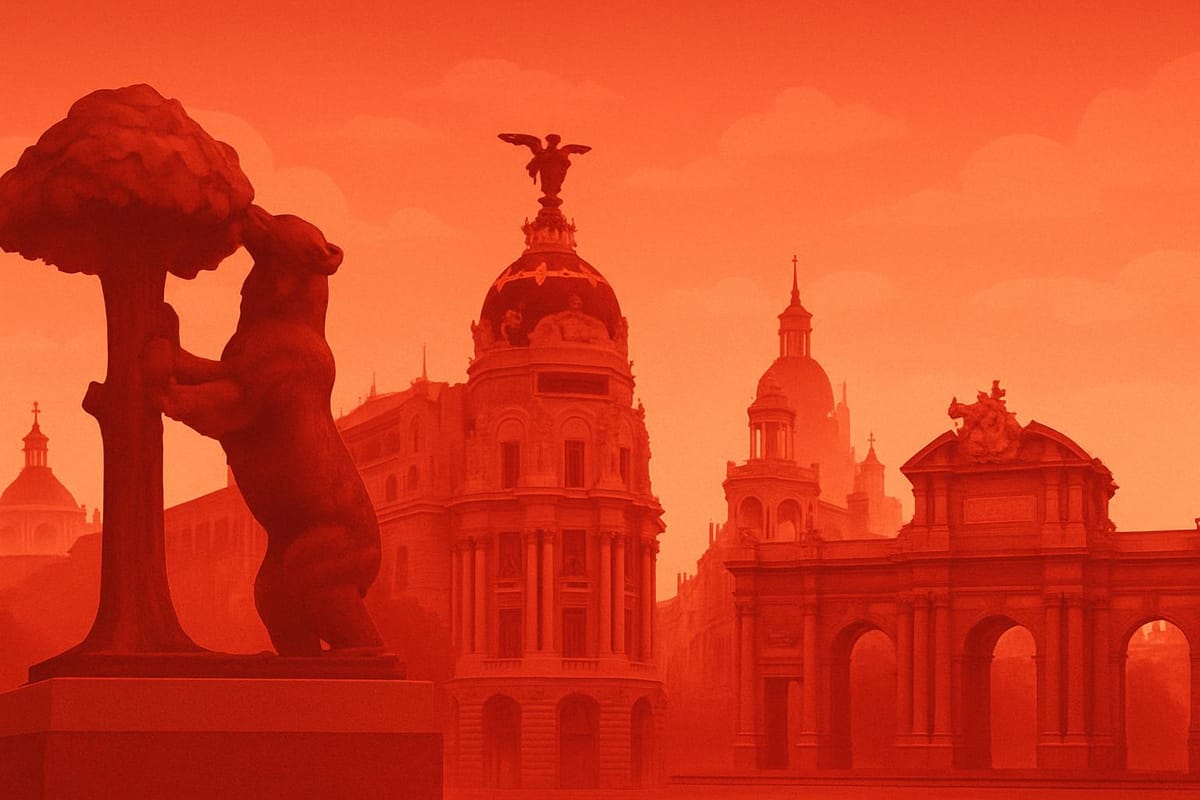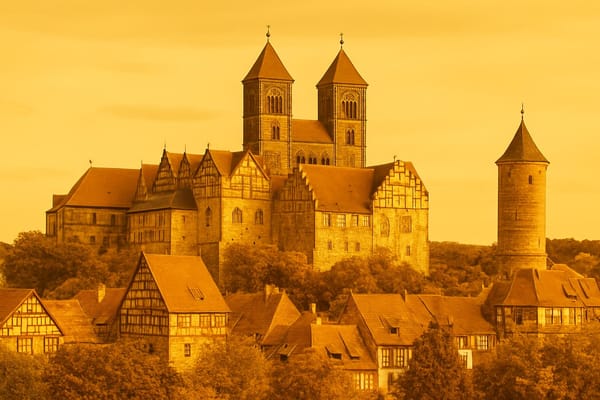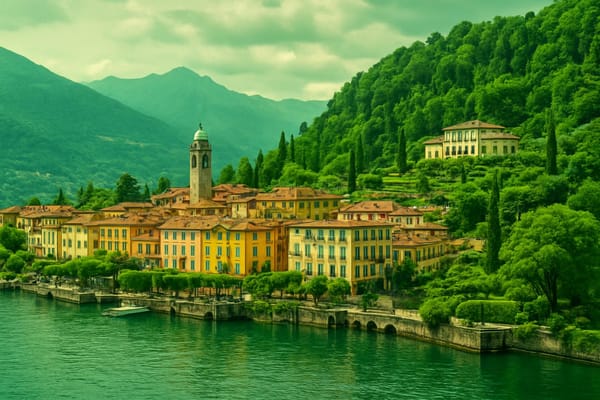Madrid
Discover world-class museums, tapas bars, flamenco, nightlife, historic plazas, royal palace, parks.

Important things to know about Madrid
Madrid, the vibrant heart of Spain, pulses with an energy that blends deep-rooted history and modern dynamism across its streets and neighborhoods. As a city, Madrid is defined by its diverse architecture, from stately boulevards and elegant residential blocks to contemporary developments, all framed by a Mediterranean-continental climate that brings hot summers and mild winters, encouraging outdoor life year-round. The local culture thrives in everyday rituals: animated cafés, bustling markets, and a strong tradition of social gatherings that emphasize warmth and conviviality. Culinary life in Madrid is a centerpiece of daily living, with a rich gastronomy scene that ranges from traditional Spanish flavors to innovative international cuisine, reflecting the city's diversity and cosmopolitan character. Madrid’s economic and creative sectors draw professionals and artists alike, fostering a lively startup ecosystem, vibrant arts communities, and an influential media presence that together shape its reputation as an urban hub. Public transportation and walkable neighborhoods make the city accessible, while green spaces and riverfront areas offer breathing room amid urban density. Nightlife and music are integral to Madrid’s identity, contributing to a 24-hour rhythm where late dinners and evening gatherings are common social norms. Residents and visitors often highlight the city’s friendly atmosphere, multicultural population, and the sense of continuous reinvention that keeps Madrid relevant on both national and international stages. Whether admired for its culinary scene, cultural vitality, or urban lifestyle, Madrid remains a compelling, ever-evolving metropolis in Spain.
Sightseeing hot-spots in Madrid
Madrid is a vibrant destination for sightseeing in Madrid and a must-visit capital of Spain where historic streets and grand plazas invite discovery. Wander from the bustling Puerta del Sol to the atmospheric Plaza Mayor, admiring Baroque facades and lively street performers while soaking up the city's centuries-old charm. The imposing Royal Palace overlooks manicured gardens and offers a glimpse into Spain's regal past, while the nearby Almudena Cathedral showcases contemporary religious art - perfect stops for travelers searching for the best things to do in Madrid.
Art lovers will find Madrid irresistible thanks to the world-famous Museo del Prado, home to masterpieces by Velázquez, Goya and El Greco, and the modern expressions at the Reina Sofía, where Picasso’s Guernica commands attention. Together with the Thyssen-Bornemisza these institutions form the Golden Triangle of Art, a top draw for cultural sightseeing in Madrid. After gallery hopping, relax in the verdant Buen Retiro Park, row a boat on the lake and enjoy outdoor concerts, a serene contrast to the city’s busy museums and historic avenues.
For a taste of modern Madrid, stroll along the bustling Gran Vía to see iconic theaters and contemporary shopping, then sample authentic Tapas at the lively San Miguel Market or a neighborhood bar - gastronomic experiences are a highlight of any Madrid itinerary. By night the city hums with flamenco shows and rooftop bars offering panoramic views, and convenient trains make rewarding day trips to Toledo or Segovia an easy addition to your travel plans. Whether you’re planning a short break or an extended stay, Madrid blends history, art and culinary delights into unforgettable sightseeing moments.
Hotels to enjoy in Madrid
Madrid is a vibrant city where hotels in Madrid range from sleek boutique hideaways to grand luxury palaces, all designed to match different traveler needs. Many Madrid hotels cluster around iconic landmarks like Gran Vía, Plaza Mayor, and Retiro Park, offering guests the advantage of a central location within walking distance of museums, tapas bars and lively nightlife. Whether you seek a budget stay with reliable free Wi-Fi and breakfast included, a romantic spot with rooftop views, or a family-friendly hotel with connecting rooms and concierge service, Madrid’s accommodation scene delivers variety and quality. Business travelers will find modern facilities, meeting spaces and easy access to public transport, while leisure visitors appreciate hotels that arrange local experiences such as culinary tours and flamenco evenings.
Choosing one of the best hotels in Madrid often comes down to balancing price, location and amenities; seasonal offers and advance reservations can yield excellent value. Many properties emphasize sustainability, multilingual staff and accessibility, and are located close to cultural highlights like the Prado and Reina Sofía museums. Reviews, photos and clear cancellation policies help guests compare options, from budget-friendly rooms near Atocha station to upscale stays with spa services and personalized concierge programs. For travelers seeking authentic Madrid charm or modern convenience, selecting the right hotel means prioritizing the neighborhood, transport links and amenities that matter most to your trip.
Restaurants to try in Madrid
Madrid's culinary landscape is a vibrant mix of traditional Spanish cuisine and cutting-edge gastronomy, making it a top destination for food lovers seeking the best restaurants in Madrid. From bustling tapas bars in La Latina to elegant dining rooms in Salamanca, the city's food scene offers something for every palate and budget. Local markets like San Miguel and diverse neighborhoods such as Malasaña showcase small plates, vermouth culture, and late-night dining that define Madrid's social eating habits. Visitors and locals alike search for the best restaurants Madrid has to offer, and they are rewarded with options ranging from cozy taverns serving classic cocido madrileño to contemporary spots led by Michelin-starred chefs crafting tasting menus that highlight seasonal, locally sourced ingredients.
Exploring Madrid's restaurant scene means discovering a fusion of heritage and innovation where quality ingredients are paired with bold creativity, creating memorable dining experiences across the city. The capital's culinary reputation is bolstered by world-class pastry shops, lively gastro-bars, and refined fine dining establishments that emphasize regional wines and attentive service. Whether you’re planning a gastronomic tour focused on tapas culture, seeking a romantic dinner at a Michelin-starred venue, or simply hunting for authentic neighborhood favorites, Madrid delivers an unmatched variety of flavors and atmospheres that solidify its place as one of Europe's most exciting culinary capitals.
Best shopping stops in Madrid
Madrid is a paradise for shopping in Madrid enthusiasts, where historic avenues and modern streets blend into an unforgettable retail experience. Strolling down Gran Vía and through the Salamanca district you will find everything from international flagship stores to exclusive luxury boutiques and ateliers showcasing Spanish designers. The mix of high-street fashion, designer labels, and independent concept shops ensures that whether you seek the latest trends or timeless pieces, Madrid delivers. Cafés and tapas bars tucked between storefronts make it easy to combine a full day of Madrid shopping with culinary stops, while department stores and elegant arcades offer curated selections that reflect Spanish craftsmanship and contemporary style.
For a more eclectic and authentic vibe, the iconic El Rastro flea market and the hip streets around Fuencarral and Chueca are must-visits, offering vintage finds, handmade goods, and unique souvenirs that capture the city’s creative spirit. Local markets and artisan shops are perfect places to discover ceramics, leather goods, and boutique perfumes, highlighting traditional techniques and modern design. Shopping in Madrid also means enjoying pedestrian-friendly plazas, seasonal sales, and events that showcase new collections and local talent, making it one of the best destinations in Europe for a diverse and memorable retail adventure. Whether you’re hunting bargains or seeking high-end pieces, Madrid’s shopping highlights promise variety, quality, and style.
Nightlife highlights in Madrid
Madrid's nightlife is a thrilling blend of tradition and modernity, where historic taverns sit beside cutting-edge cocktail bars and late-night clubs. Strolling from Gran Vía to Malasaña you'll find rooftop terraces with panoramic views, cozy tapas bars pulsing with local energy, and intimate venues hosting authentic flamenco shows. The evening often begins with small plates and conversation, then shifts to live music in eclectic neighborhoods like Chueca and La Latina, where DJs and bands keep the rhythm alive until dawn. For visitors seeking an unforgettable night out, Madrid offers everything from elegant cocktail lounges to underground clubs, making it a top destination for those who want dynamic urban fun and cultural experiences in one weekend.
As the hours grow late, Madrid's clubs and live-music venues reach full intensity, attracting a diverse crowd eager for dancing, craft cocktails, and late-night bites. The city’s transport options and late opening hours mean you can hop between venues across neighborhoods, discovering new sounds and atmospheres. Whether you prefer a sophisticated evening on a rooftop, an electric DJ set in a club, or an intimate acoustic performance in a bar, Madrid’s vibrant mix of bars, clubs, and cultural hotspots ensures memorable nights for locals and tourists alike. Enjoy the rhythm, sample the tapas, and immerse yourself in the legendary Madrid nightlife.
Getting around in Madrid
Madrid's airport and train situation offers travelers efficient connectivity and growing capacity: Adolfo Suárez Madrid-Barajas Airport is Spain's busiest hub with four major terminals (including the modern Terminal 4) handling extensive international and domestic routes, while direct links to the city center via Metro Line 8, airport express buses, taxis and rideshares make arrivals and departures straightforward; on the rail side, RENFE operates a dense network from central stations Atocha and Chamartín, where AVE high-speed trains connect Madrid to Barcelona, Seville, Valencia and the rest of Spain in just a few hours, and the Cercanías commuter lines provide frequent, reliable service across the metropolitan area for daily commuters and tourists alike, with integrated ticketing options that improve transfers between airport and train services; recent investments in station upgrades, timetable coordination and expanded international flight routes have strengthened Madrid’s role as a transportation hub, so whether your priority is speed, affordability or frequent connections, the Madrid transport system delivers competitive options and clear pathways to explore Spain and beyond.
Culture must-see's in Madrid
Madrid is a thriving epicenter of art, history and contemporary life, and the culture highlights of Madrid are impossible to ignore. From world-class collections housed at the Prado Museum, Reina Sofía and Thyssen-Bornemisza to the imposing silhouette of the Royal Palace and the timeless charm of Plaza Mayor, the city blends centuries of art and architecture with lively public spaces. Strolling through Retiro Park or along the elegant boulevards of Gran Vía reveals an urban fabric where classical galleries, modern museums and historic churches coexist with cutting-edge design and street art. Theatres showcasing Spanish drama and international productions, museums that trace the arc of European painting, and cultural institutions committed to contemporary practice all make Madrid a top destination for anyone searching for rich cultural experiences in Spain.
Beyond museums and monuments, Madrid’s vibrant social culture fuels its reputation as a capital of gastronomy, music and nightlife. The tradition of tapas and convivial dining in neighborhoods like La Latina and Salamanca complements lively flamenco nights and experimental music venues in Malasaña, and seasonal festivals such as San Isidro reinforce the city’s community spirit. Markets, culinary tours, independent galleries and pop-up exhibitions showcase both classic and emerging talent, while intimate tablaos present authentic flamenco and passionate performances. Whether exploring historic museums, sampling local cuisine, or joining a late-evening cultural stroll, visitors discover why the museums in Madrid, the theaters, and the bustling street life together define the unforgettable cultural heartbeat of the Spanish capital.
History of Madrid
Madrid’s history of Madrid begins long before it became the vibrant Spanish capital known today. The city grew from a small Medieval settlement on the River Manzanares, originally fortified as Mayrit by Muslim rulers, into a strategic Castilian stronghold after the Christian reconquest. Its central location on the Iberian plateau made Madrid a key crossroads for trade and administration, and the erection of royal residences consolidated its importance. When King Philip II designated Madrid the seat of the court in 1561, the city experienced a transformation: narrow medieval streets gradually gave way to grand public spaces such as Plaza Mayor and later the imperial Royal Palace, built upon the ruins of the old Alcázar. The Almudena Cathedral and the bustling Puerta del Sol became focal points, reflecting both sacred and civic life. This early modern period laid the groundwork for Madrid’s identity as the political heart of Spain, a place where aristocratic palaces, artisan workshops, and lively markets shaped a diverse urban culture.
The modern chapter of Madrid history is marked by cultural flourishing, urban expansion, and political upheaval. The Bourbon reforms of the 18th century ushered in Enlightenment-era institutions and monumental projects like the Prado Museum, established to showcase Spain’s artistic heritage alongside later cultural centers such as the Reina Sofía and Thyssen collections. The 19th and 20th centuries brought dramatic growth with the arrival of railways, the creation of green spaces like Buen Retiro, and iconic thoroughfares including Gran Vía, which symbolize Madrid’s commercial dynamism. The city endured trials during the Spanish Civil War, suffering damage and social fracturing, and later underwent reconstruction and modernization through the Franco era into the democratic transition. Today, Madrid stands as a global metropolis and a hub for art, cuisine, and finance-its museums, parks, and historic neighborhoods attracting millions of visitors. The ongoing evolution of Madrid-from medieval stronghold to cosmopolitan capital-continues to shape Spain’s national story, ensuring that the city’s layered past remains central to understanding the broader history of Spain and the continued vitality of the Spanish capital.



